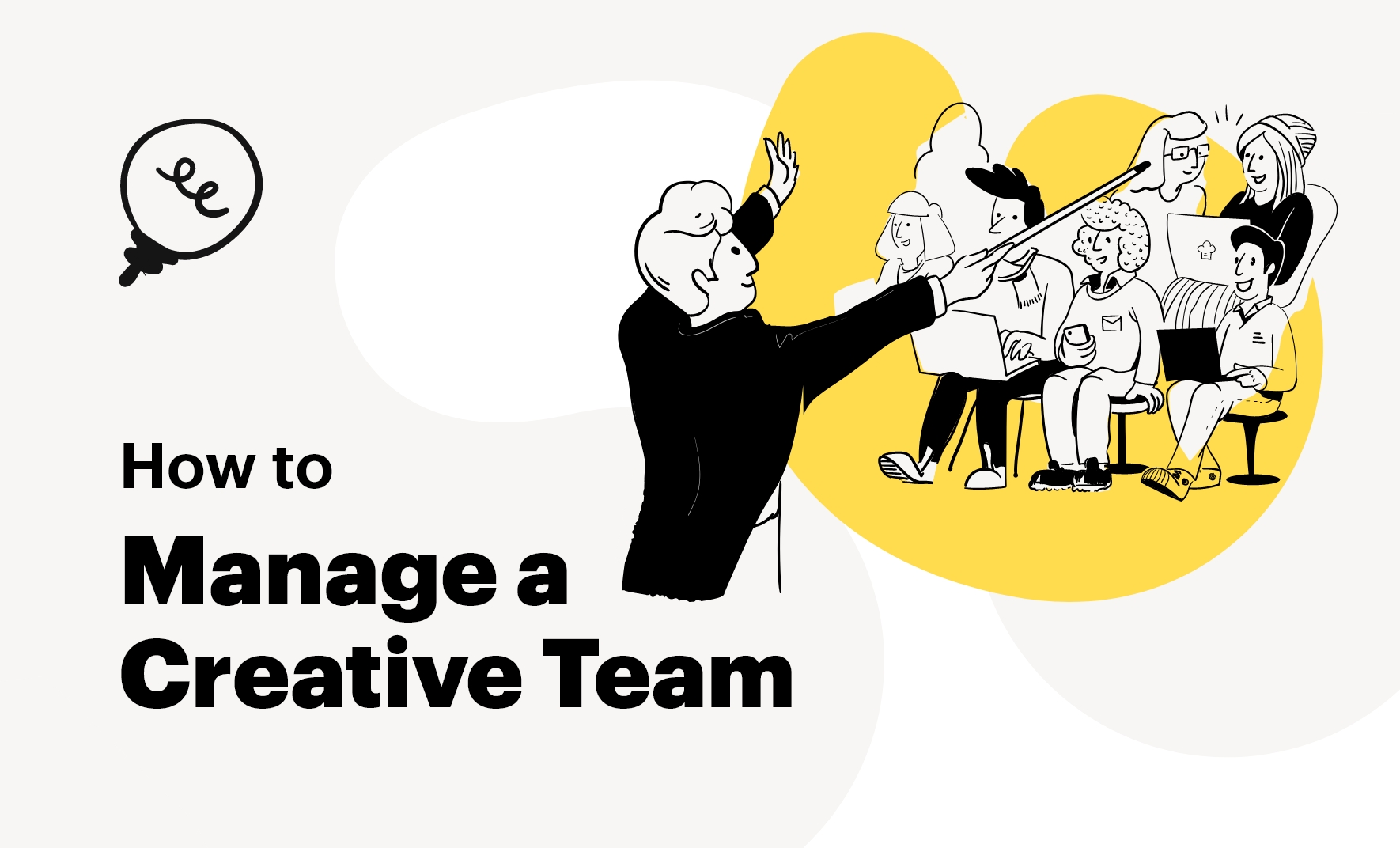How To Manage a Creative Team

Management is a skill, managing a team of creatives is perhaps an even harder skill.
It’s an area that traditional management philosophies and methods rarely take into consideration. Every team is made up of individuals, after all, and you have to be able to get the best out of them. However, managing teams that are made up totally of creative types can be like being thrown into the lion’s den when you are used to working with cats. Management styles and leadership skills that will be great for certain businesses, may have almost the opposite effect on the creative environment you wish to instill and the talented, creative individuals you need on your side.
But if you can make it work, it can pay off big time. Nobody ever said managing the Beatles or The Stones was easy, but look at the results, the genius that is possible.
The task, like in all management is to get the job done, and produce the results that matter. You might need to find different ways of doing things and different styles of handling people- you may even have to think creatively yourself. It’s not impossible, but it needs some work.
What is a Creative Team?

When we talk about creative teams we are mainly referring to the ideas people who come up with the vision and design. This could be as obvious as a graphic design team, a web design team with UX/UI specialists, a branding company or it could even be a marketing campaign team. It is the team members who take the business’s goals and brief and produce the ideas and vision that will bring them to life.
It will be made up of different characters with different skills and will often have to integrated into other branches of development. But here we are talking about the bright sparks that create, the visionaries, the brainstormers, the artists, and the inspiration. It sounds good. But we can just as easily be talking about the oddballs, the whingers, the moaners, the ones that flair up, the loners, the high spirited, unconventional, mavericks.
They all need managing.
Creative Teams Need an Inspirational Atmosphere
In a perfect world, all leaders should be inspiring but in the creative world more than most it is vital that you gain respect. You don’t have to be a creative genius yourself, although that is one way of gaining instant kudos. whilst it might give you a head start in the “respect” game, without the people and management skills to back it up that standing can soon be lost. In fact, the most creative creatives are often not the best leaders of creatives. They can find it difficult to relate to staff and unable to see the bigger picture.
The most effective leaders are the ones that can create a positive atmosphere and allow the team players to flourish to their full potential. Management is about leading the whole team not about plowing your own furrow. A great creative talent, who everybody wants to aspire to, may well be a superb addition to a team. This doesn’t necessarily make them the ideal candidate for a leadership role.
Inspiration here is the empowerment, the direction, the soft skills, the encouragement, and fostering of an environment that will get the best out of the team, in order to produce the best results. For tips on exactly how to do that, read on.
Tips for Managing a Creative Team
Unfortunately, like in many areas of life, there is no 100% plan to guarantee success. The best managers of creative teams are the ones that are open-minded and flexible, they can vary their approach depending on the circumstances and the individuals involved. They work with individuals but still manages to promote a team ethic, a spirit of mutual respect and they understand the creatives that work for them and importantly with them. Whilst it is true that nothing will guarantee success, there are some general guidelines that can make managing creative teams, a whole lot easier.
1. Paint the Big Picture
As a rule, creatives don’t usually do detail, or at least that’s not what inspires their creative juices to flow. As a leader of creatives, you would be well advised to get the team involved in the early stages of a project. Give them the broad outline, and feed on their ideas. Let them get excited and let their imagination take hold.
In such a way you benefit from their ideas but you also give them a sense of ownership. Creatives like to feel their work is solving the puzzle not organizing and putting the pieces in place.
2. Lead – but From the Back Seat
Your leadership should be respected, and for this reason, it should be decisive and accept the responsibility. But this doesn’t mean you have to lead from the front, pulling everyone with you. In fact, as far as leading creative teams is concerned it’s better to take a back seat and push and prod in the right direction and not try to drag people kicking and screaming along with you.
Creatives need leadership, and when done well they absolutely value it and realize it’s worth. But creative teams also benefit from independence, a sense of responsibility, and ownership. The key is to find the balance between the trust you have in your team and the time to draw the line and change direction when needed.
Great managers of creative teams realize that their value to the team is pulling the pieces together and getting them facing the right way and traveling along the right path. Truly great managers of creative teams know what they are good at, and what their role is – and in this way, they do what they do when needed. The rest of the time trust in the abilities and experience of their team.
Less is more.
3. Clear Guidelines
One of the most frightening things for any creative is the total blank page. Even the most imaginative need a beaten path, even if it’s only there to veer off from.
Giving clear project or task guidelines for a project from the start is not constraining your ideas people, it is giving them the foundation to take the leap and telling them where the final destination is going to be. The team needs to understand what they are working for, the goal, the aim, and the client’s needs – if only so they can rebel against it.
Guidelines are what create the structure allows that all teams, even creative teams to flourish.
- The Brief
Clear goals, clarity of who is responsible for what, break down of tasks, a roadmap to project completion – it seems obvious but it often isn’t given enough thought. To produce the wanted result, you must know the result wanted.
Once you have the overall brief from the client, then get the team involved. Create the ownership, generate the excitement, and use the talent available. Discuss, brainstorm, listen to opinions, consider and come up with a process of creation. This is the brief, this is the template you are all working from and the agreed outcomes. Whilst it may change, it may be flexible, it is important to have a solid base to come back to and to deviate from.
This is the structure that gives the creative force its power. The skeleton that the creatives can clothe, and without a good mannequin the clothes are never going to look their best no matter on the fashion designer.
- Style Guides
Creating a style guide is another way of adding structure to your creative team. This helps create consistency in the designs or campaigns. It can be a set of best-practice ideas, from fonts and typefaces to colors, from document formatting to layout. This guide is exactly that, a guide. It is not a totally predefined system but can and should change over time. It does, however, provide your creatives with the basis for their work.
This kind of style guide is extremely useful when you have an in-house team of creatives working for your own business, but equally valuable when you are working on projects for other clients. By going through these guidelines with your clients you can get a more exact picture of what they want and where they want to be, or even if they want to give you a totally free hand.
- Standards
Standards could refer to your own company values and ethos and how you treat others within the business. It could also refer to the practicalities and processes you put in place during a project, such as your methods and frequency of communication, or processes for transferring files and collaborating.
Your standards need to be standard. These are the structures that hold the team together, what makes you more than a series of freelancers. They need to be enforced if necessary but perhaps more importantly they have to be known, they have to be accepted and they have to be essential in your company culture.
4. Collaborate Not Compete
Does competition get the best out of people? In some cases this might be true, a dog eat dog environment in sales or financial industries has certainly had an effect. Unfortunately, for creative teams, it often seems to have a negative effect on both job satisfaction and results. Even great creative works are often in effect achieved by groups or at the very least with the help of a background cast of family or followers.
In creative teams, the building of a collaborative, cooperative culture and environment has been shown to improve performance with few exceptions. This doesn’t mean that team members can’t work individually or have the autonomy, in fact, this is often to be encouraged. What it does mean is, that team members can share ideas, thoughts, encouragement, and feedback. That communication and collaboration should be encouraged and that everyone is pulling in the same direction
It is also essential to foster an environment of mutual respect and support not only on a personal level but also for their own skills and talents. Creatives who feel relaxed and confident in their work produce better results. Help from collaboration and encourage peer support by utilizing different skills in joint projects and organizing work teams.
5. Help Creatives Create
Creatives want to create. That’s why they’re in this job in the first place and that is exactly what you want them to do. A leader or manager’s job is to help facilitate this creativity. You can do this by providing an atmosphere that is open, encouraging, and collaborative. A place where creative people feel comfortable experimenting and sharing thoughts and ideas. This comes from how you treat and encourage the workers but also in the team you have assembled and how you manage the expectations and plan the work.
You can also help the atmosphere by affecting the physical space. Arrange space for joint communal areas, to encourage mixing. Plenty of light and space will give the sense of freedom that inspires creativity. Bright, lively, well-designed decor contributes to the atmosphere of a workspace too. True creative pull their creativity not only from the inside but also from the inspiration of things and people around them.
6. Constructive, Frequent Feedback
In all areas of management, you need to recognize and appreciate the work that people are doing for the cause. Creatives, often being highly sensitive, value appreciation, and praise for their work. it motivates them and inspires them as well as giving them confidence.
Whilst praise is quite natural to give at the end of a completed piece, it is important to remember to give constructive feedback during the creative process. Frequent constructive feedback is not the micromanagement that should be avoided. It is the guidance down the right path, and it is the emotional support that helps move the project onwards, and upwards.
If you make frequent catch-ups and feedback a part of your management routine, it becomes part of the normal creative process. The employee doesn’t feel watched or their work constantly questioned and fashioned. However, the process helps not only to provide that extra push and spark but also to halt things that are going drastically in the wrong direction.
What to Avoid When Managing a Creative Team

Sometimes good management means avoiding bad management. Once you’ve put these strategies in place for managing your creative team, stick with those philosophies and try not to fall into the traps that can so easily drag you in.
1. Over-Manage
Managing from the backseat gives the creative team the freedom that they require but it’s not always so easy. As a manager, you often feel the need to get involved and know exactly what’s going on all the time. You need to find the balance between allowing creative freedom, giving the creative responsibility, and managing the overall process. Trust in your team but be there for them when they need you.
2. Letting Things Drift
Your job is to lead not let your creatives have carte blanche. Once you’ve planned the work, and delivered the brief you should give them freedom to create to the experts but this is still a business deal. Whilst not micromanaging every aspect, every minute, there is still an important role to play to keep things on track. Keeping people organized, focused, and within the brief helps the business and crucially helps the creative.
3. Using Your Creatives for Non-Creative Work
To get the best out of your creative team you need to give them work that is suitable for their skills. Anyone can do extra paperwork and documentation, even you could do your fair share. Let the creative, create, and let the admin, administer. Use the creative talent for creation.
4. Stressing and Pressurizing Your Team
There will of course be stress and pressure in any business environment but if you really want to get the best out of your creative team, it is best to try to protect them from this as much as possible. Provide a protective bubble to encourage the risk-taking and creative genius that this may bring about. If you are going to bring them into the real world of deadlines and timelines, then bring them onside by rational and logical explanations of consequences and demands, rather than shouting and balling. Keep them working for you as opposed to working against the clock.
Summary
Creative team management is about finding a balance between the usual management practices of control and planning and utilizing the special talents that are in your team. These are not mutually exclusive and you shouldn’t see them as such. Remember that creative people thrive when they have the freedom to express themselves but thrive best when this freedom is within a comfortable and safe environment. As a manager, you need to create a structure and atmosphere where your team can flourish but still come up with the goods. Where the process and results both matter to the workers. where individuals value themselves and the team that they are part of and value you as playing an integral role in their success. Couldn’t be easier, could it?